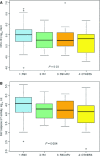Lactate dehydrogenase and caspase activity in nasopharyngeal secretions are predictors of bronchiolitis severity
- PMID: 25132512
- PMCID: PMC4262276
- DOI: 10.1111/irv.12276
Lactate dehydrogenase and caspase activity in nasopharyngeal secretions are predictors of bronchiolitis severity
Abstract
Background: Bronchiolitis is the leading cause of hospitalization in infants. Biomarkers of disease severity might help in clinical management.
Objective: To determine the clinical predictiveness of NW-LDH, NW-caspase 3/7, and NW-LDH/NW-caspase 3/7 ratio in bronchiolitis.
Methods: Previously healthy children less than 24 months of age with bronchiolitis were recruited from the Texas Children's emergency room and intensive care unit from October 2010 to April 2011. Demographic, clinical information, and NW samples were obtained at enrollment. NW samples were analyzed for respiratory viruses, caspase 3/7, and LDH.
Results: A viral pathogen was detected in 91·6% of 131 children, with the most common being respiratory syncytial virus and human rhinovirus. A single infection was found in 61·8% of subjects and co-infection in 29·8%. Children admitted to ICU had significantly higher NW-LDH than children sent home from the ER or admitted to the general floor (P = 0·02). Children infected with RSV had the highest NW-LDH concentration (P = 0·03) compared with other viral infections. NW-LDH and NW-caspase were significantly correlated (r = 0·77, P < 0·0001). The univariate models showed NW-LDH and NW-LDH/NW- caspase 3/7 ratio were directly associated with hospitalization. Mutivariate regression analyses suggested a complex interaction between the biomarkers, demographics, and disposition.
Conclusions: NW-LDH, NW-caspase 3/7 and NW-LDH/NW-caspase 3/7 ratio and their interactions with demographic factors are predictive of bronchiolitis severity and can help distinguish children requiring ICU-level care from those admitted to the general floor, or discharged home from the emergency center.
Keywords: Bronchiolitis; caspase; disease severity; lactate dehydrogenase.
© 2014 The Authors. Influenza and Other Respiratory Viruses Published by John Wiley & Sons Ltd.
Figures



Similar articles
-
LDH concentration in nasal-wash fluid as a biochemical predictor of bronchiolitis severity.Pediatrics. 2010 Feb;125(2):e225-33. doi: 10.1542/peds.2009-0411. Epub 2010 Jan 25. Pediatrics. 2010. PMID: 20100751 Free PMC article.
-
Nasopharyngeal lactate dehydrogenase concentrations predict bronchiolitis severity in a prospective multicenter emergency department study.Pediatr Infect Dis J. 2012 Jul;31(7):767-9. doi: 10.1097/INF.0b013e3182565eae. Pediatr Infect Dis J. 2012. PMID: 22517336 Free PMC article.
-
Acute bronchiolitis: Influence of viral co-infection in infants hospitalized over 12 consecutive epidemic seasons.J Med Virol. 2018 Apr;90(4):631-638. doi: 10.1002/jmv.24994. Epub 2017 Dec 11. J Med Virol. 2018. PMID: 29226974 Free PMC article.
-
[Respiratory syncytial virus infection and asthma].Allergol Immunopathol (Madr). 2001 May-Jun;29(3):140-6. doi: 10.1016/s0301-0546(01)79034-9. Allergol Immunopathol (Madr). 2001. PMID: 11434889 Review. Spanish.
-
Lactate dehydrogenase and the severity of adenoviral pneumonia in children: A meta-analysis.Front Pediatr. 2023 Jan 26;10:1059728. doi: 10.3389/fped.2022.1059728. eCollection 2022. Front Pediatr. 2023. PMID: 36776678 Free PMC article. Review.
Cited by
-
A novel combined nomogram for predicting severe acute lower respiratory tract infection in children hospitalized for RSV infection during the post-COVID-19 period.Front Immunol. 2024 Jul 24;15:1437834. doi: 10.3389/fimmu.2024.1437834. eCollection 2024. Front Immunol. 2024. PMID: 39114651 Free PMC article.
-
The interdependencies of viral load, the innate immune response, and clinical outcome in children presenting to the emergency department with respiratory syncytial virus-associated bronchiolitis.PLoS One. 2017 Mar 7;12(3):e0172953. doi: 10.1371/journal.pone.0172953. eCollection 2017. PLoS One. 2017. PMID: 28267794 Free PMC article.
-
Value of cardiac enzyme spectrum for the risk assessment of mortality in critically ill children: a single-centre retrospective study.BMJ Open. 2024 Oct 16;14(10):e074672. doi: 10.1136/bmjopen-2023-074672. BMJ Open. 2024. PMID: 39414301 Free PMC article.
-
Infant-derived human nasal organoids exhibit relatively increased susceptibility, epithelial responses, and cytotoxicity during RSV infection.J Infect. 2024 Dec;89(6):106305. doi: 10.1016/j.jinf.2024.106305. Epub 2024 Oct 9. J Infect. 2024. PMID: 39389204 Free PMC article.
-
Pediatric human nose organoids demonstrate greater susceptibility, epithelial responses, and cytotoxicity than adults during RSV infection.bioRxiv [Preprint]. 2024 Feb 1:2024.02.01.578466. doi: 10.1101/2024.02.01.578466. bioRxiv. 2024. Update in: J Infect. 2024 Dec;89(6):106305. doi: 10.1016/j.jinf.2024.106305. PMID: 38352333 Free PMC article. Updated. Preprint.
References
-
- Pannozo CA, Fowlkes AL, Anderson LJ. Variation in timing of respiratory syncytial virus outbreaks. Lessons from national surveillance. Pediatr Infect Dis J. 2007;26:S41–S45. - PubMed
-
- Light M. Respiratory syncytial virus seasonality in Southeast Florida. Results from three area hospitals caring for children. Pediatr Infect Dis J. 2007;26:S55–S59. - PubMed
-
- Papadopoulos NG, Moustaki M, Tsolia M, et al. Association of rhinovirus infection with increased disease severity in acute bronchiolitis. Am J Respir Crit Care Med. 2002;165:1285–1289. - PubMed
-
- Midulla F, Scagnolari C, Bonci E, et al. Respiratory syncytial virus, human bocavirus and rhinovirus bronchiolitis in infants. Arch Dis Child. 2010;95:35–41. - PubMed
Publication types
MeSH terms
Substances
Grants and funding
LinkOut - more resources
Full Text Sources
Other Literature Sources
Medical
Research Materials
Miscellaneous

